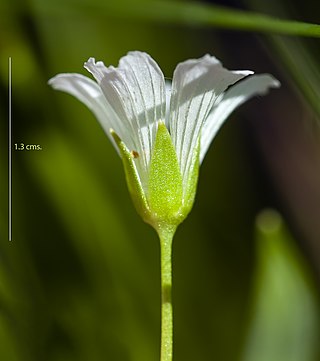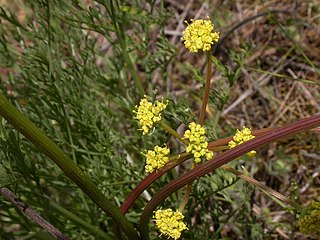
Limnanthes douglasii is a species of annual flowering plant in the family Limnanthaceae (meadowfoam) commonly known as Douglas' meadowfoam or poached egg plant. It is native to California and Oregon, where it grows in wet, grassy habitat, such as vernal pools and spring meadows. It can grow in poorly drained clay soils. The plant was collected by the Scottish explorer and botanist David Douglas, who worked on the west coast of America in the 1820s.

Limnanthes alba is a species of flowering plant in the meadowfoam family known by the common name white meadowfoam. It is native to California and Oregon, where it grows in wet grassy habitat, such as vernal pools and moist spots in woodlands. It generally grows in poorly drained soils. It is an annual herb producing an erect or decumbent stem up to about 30 centimeters long. The leaves divided into several lobed or unlobed leaflets. The flower is cup-shaped with white petals 1 to 1.5 centimeters long.

Mount Arrowsmith is the highest mountain east of Port Alberni on Vancouver Island. Its dominant rock is basalt. The mountain is contained within the Mount Arrowsmith Biosphere Region and as of September 18, 2009 is designated part of 1,300 ha hectare Mt. Arrowsmith Massif Regional Park.

Limnanthes, the type genus of the family Limnanthaceae, consists of annual herbaceous plants commonly known as the meadowfoams. The seven species are all native to coastal and adjoining regions of western North America, where they typically grow in marshy habitats, such as the margins of vernal pools. Some are endemic to California.

Limnanthes vinculans, the Sebastopol meadowfoam, is an endangered species of meadowfoam found only in the Laguna de Santa Rosa in Sonoma County, California, United States and an area slightly to the south in the Americano Creek and Washoe Creek watersheds. The name vinculans derives from the Latin root vinculum, meaning "a bond, a cord." The specific epithet vinculans means linking or bonding, in reference to the sharing of some characters of L. vinculans with L. douglasii (R.Br) and L. bakeri.

John Macoun was an Irish-born Canadian naturalist.

Gentianopsis is a genus of flowering plants in the gentian family known commonly as fringed gentians. These are similar to the gentians of genus Gentiana. Most have flowers which are blue to purple in color. They may be annual or perennial. They are native to Eurasia and temperate North America.

Blennosperma bakeri is a rare species of flowering plant in the daisy family known by the common names Baker's stickyseed and Sonoma sunshine.

Limnanthes floccosa, or woolly meadowfoam, is a species of meadowfoam found in Northern California and Southern Oregon, in the United States. Most of the subspecies have highly restricted distributions and are listed as critical or endangered.

Limnanthes bakeri is a rare species of meadowfoam known by the common name Baker's meadowfoam. It is endemic to Mendocino County, California, where it is known from only about 20 occurrences in the vicinity of Willits. It is a plant of wet, grassy habitat such as vernal pools and marshy spring meadows.
Limnanthes montana is a species of meadowfoam known by the common name mountain meadowfoam. It is endemic to the Sierra Nevada foothills of California, where it grows in wet, grassy habitat such as marshy spring meadows.
Limnanthes striata was formerly a species of meadowfoam known by the common name foothill meadowfoam. It has recently been subsumed into the species Limnanthes douglasii in both the Jepson Manual and the Flora of North America. This plant is endemic to California, where it is known from the Sierra Nevada foothills and the southern Klamath Mountains. It grows in wet, grassy habitat, carpeting the edges of vernal pools and ephemeral creeks.

Ranunculus macounii is a species of buttercup known by the common name Macoun's buttercup. It is native to much of North America, from Alaska and northwestern Canada to Newfoundland and Labrador, and the contiguous United States except for the northeast and southeastern areas. It grows in many types of moist habitat, including marshes and wet areas woodlands and scrub. It is generally semi-aquatic, growing in or next to shallow water, or in muddy places. It is a perennial herb producing prostrate, spreading stems that root at nodes that come in contact with moist substrate, or growing erect and branching. The stems are generally hairy, but populations of hairless specimens are known. The leaves are mostly divided into three lobed, toothed leaflets which are borne on long, hairy petioles. The flowers each have five shiny yellow petals under a centimeter long around a center of many stamens and pistils. The fruit is an achene borne in a spherical cluster of 20 or more.

Lomatium cookii is a rare species of flowering plant in the carrot family known by the common names Cook's lomatium and agate desertparsley. It is endemic to Oregon in the United States, where it grows in only two valleys. It is a federally listed endangered species.
Oeneis macounii, the Canada Arctic or Macoun's Arctic, is a butterfly of subfamily Satyrinae that occurs in North America.

Mount Macoun is a 3,030-metre (9,940-foot) mountain summit located in Glacier National Park of British Columbia, Canada. It is part of the Selkirk Mountains range. The mountain is a remote 61 km (38 mi) east of Revelstoke, and 32 km (20 mi) southwest of Golden. Its nearest higher peak is Mount Fox, 3.7 km (2.3 mi) to the southwest, and Mount Topham rises 4.4 km (2.7 mi) to the south. The expansive Illecillewaet Névé lies to the northwest, and two small unnamed glaciers lie at the bottom of the steep east face. Precipitation runoff from the mountain drains into the Beaver River.













